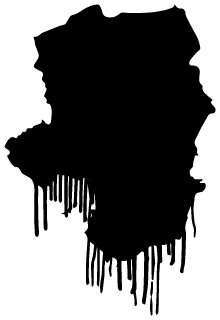
Hubert Czerepok, Counter-revolution, 2016.
Mural project in Budapest, unrealized.
BRIDGE OVER TIME. CONTEMPORARY PICTURE OF THE PAST
Project manifesto
The fall of the Berlin Wall is a symbolic breaking of the iron curtain. And thus a break with the post-Yalta past. Admission of Central European countries to the European Union is their symbolic rebirth. The political history in the countries subjected to Soviet domination after the Second World War was different, but similar, insofar as the social reality is similar in all totalitarian countries. And art in these countries has a different but similar history. Contemporary art, i.e. art of conceptual and post-conceptual forms that has been dominant on the art scene since the sixties, brought various individual solutions, but the trend itself was similar. Just like its theoretical basis.
Shaping art forms depending on the political and social context was also similar and different. Conceptualism was artistic means, which in all Central European countries was used as political means. Conceptual = political. This was the dominant assumption of contemporary art creators. The autonomy of the conceptual art means, tautology as an artistic form, even if they did not contain political content, paradoxically, they were political by the mere inherent critique of the traditional definition of art and the desire to subversive, reevaluation all values.
Such a synthetic approach to the past is possible from the perspective of the present. Contemporary art created today is largely post-conceptual. Such a continuum can also be proved in research on the art of the region. But the breakthrough was so profound, shock, And this shock, similar and different, created a distance towards the history of art in countries undergoing transformation. Past and present have been separated. Three decades have already passed since then. And most importantly, we are in one area of the EU.
All this indicates that there has been a new opening, a re-birth of art in these post-conceptual countries, similar and different from its counterpart from the sixties – seventies – eighties. Our today’s look at the various art of that time is not only an objectified historical research, but also a reinterpretation and re-actualization of history in today’s times. Reconstruction is a construction, reenactment is a new action. We return to history as a new present.
The history of conceptualism as a political art created in totalitarian countries is situated in the context of the art created in these countries today. The lesson in art history is a lesson about contemporary art in the orbit of the EU and the free world. The image of history is shaped by the present. History looks at today as in a mirror and sees its image. The differences and similarities of the past are significant for today. A bridge over time that connects contemporary and history.
by Łukasz Guzek
